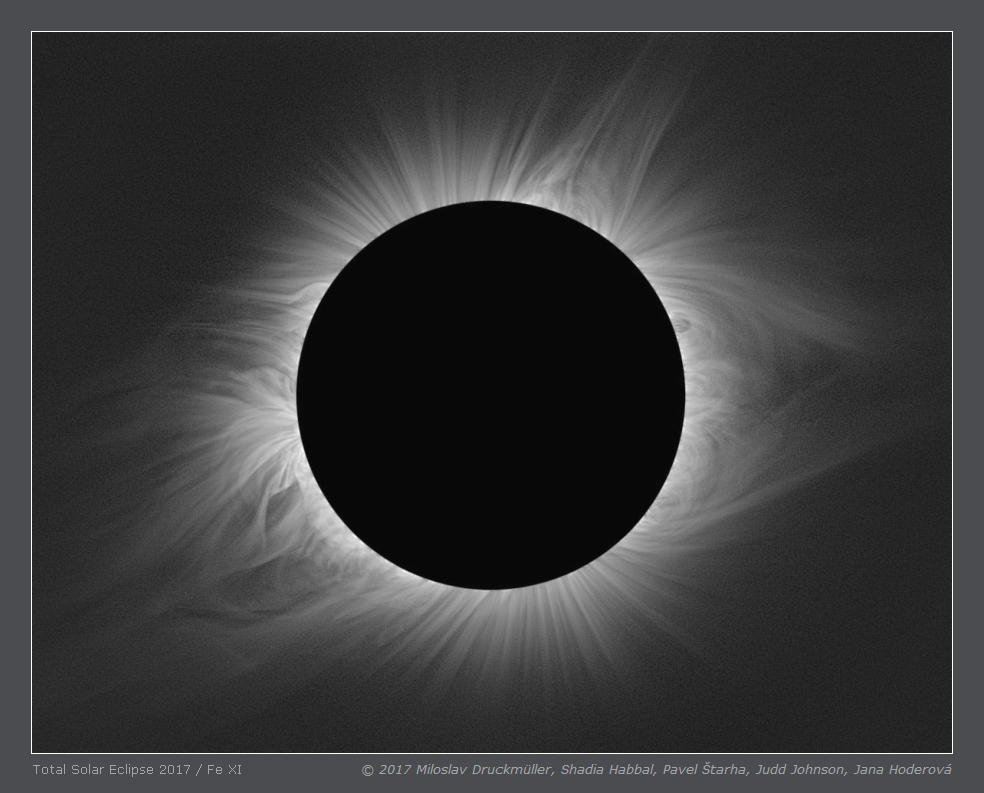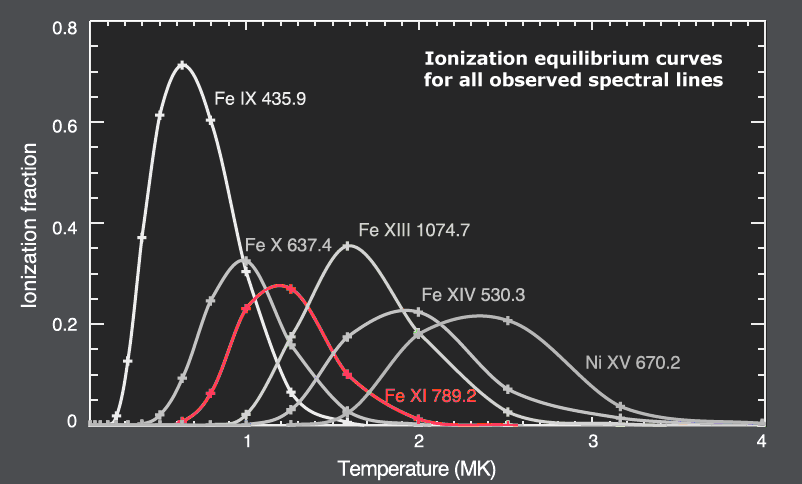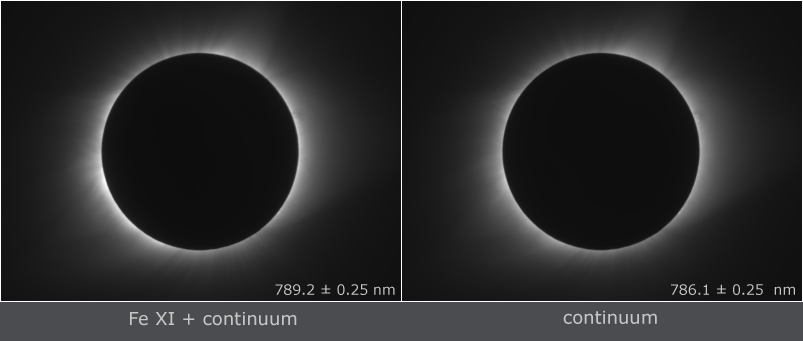
Fe XI, 789.2 nm
Our expedition observed emission of following ions in the visible
and near IR wavelength range: Fe IX (435.9 nm), Fe X (637.4 nm),
Fe XI (789.2 nm), Fe XIII (1074.7 nm), Fe XIV (530.3 nm) and
Ni XV (670.2 nm). These emission lines provide an excellent
diagnostic tool
for probing the physics of the solar corona. This is clear from the following graph. Fe XI line
at 789.2 nm is very interesting because
Fe XI ion is the most
dominant ion of all Fe ions in solar corona.
 Even though Fe XI is a relatively strong near-IR emission line, it
is not easy to obtain an image of Fe XI. It is not as simple as deep sky photography of emission
nebulae where only sufficiently narrow band filter is needed to isolate the emission line. The emission in the
solar corona is dominated by continuum - photospheric light scattered on free electrons. The light emitted
by different atoms and ions is very weak relative to the continuum. See the following two unprocessed images.
The
left one was taken through a narrow band filter (bandwidth 0.5 nm) with a transmission band centered on the
Fe XIV 789.2 nm emission line. The right image was taken through a filter with transmission band
outside the Fe XI line in the continuum. It is clearly visible that the left image is highly contaminated
by continuum irradiance. It is not advisable to use a filter with a narrower band of transmission because
the emission line is thermally broadened; if the filter is too narrow, the situation becomes even worse.
Therefore it is necessary to make a precise photometric calibration of all images and then subtract the
continuum - the right image from the left one. You may see these two images as an
animation.
Even though Fe XI is a relatively strong near-IR emission line, it
is not easy to obtain an image of Fe XI. It is not as simple as deep sky photography of emission
nebulae where only sufficiently narrow band filter is needed to isolate the emission line. The emission in the
solar corona is dominated by continuum - photospheric light scattered on free electrons. The light emitted
by different atoms and ions is very weak relative to the continuum. See the following two unprocessed images.
The
left one was taken through a narrow band filter (bandwidth 0.5 nm) with a transmission band centered on the
Fe XIV 789.2 nm emission line. The right image was taken through a filter with transmission band
outside the Fe XI line in the continuum. It is clearly visible that the left image is highly contaminated
by continuum irradiance. It is not advisable to use a filter with a narrower band of transmission because
the emission line is thermally broadened; if the filter is too narrow, the situation becomes even worse.
Therefore it is necessary to make a precise photometric calibration of all images and then subtract the
continuum - the right image from the left one. You may see these two images as an
animation.
 More images of Fe ion emission obtained during the 2017 eclipse can be found on the following pages:
More images of Fe ion emission obtained during the 2017 eclipse can be found on the following pages:
Click on the image or on the following reference to display the
higher resolution image version (893 KB, PNG format).
|
| Image | Fe_XI_Mitchell_ACHF.png |
| Date | 21. 08. 2017 |
| Time | 2nd contact 17:21:11 UT, 3rd contact 17:23:14 UT |
| Place | near Mitchell, Oregon, USA |
| Coordinate | N 44° 31.539', W 119° 54.459', Alt. 1100 m |
| Conditions | Clear sky but some smoke from forest fires, solar altitude 43° above horizon |
| Optics | 2× Achromat 4/300 mm equipped with following narrow band filters:
On-band filter: Andover, center wavelength: 789.2 nm, bandwidth 0.5 nm
Off-band filter: Andover, center wavelength: 786.1 nm, bandwidth 0.5 nm |
| Camera | 2×Atik 414EX |
| Exposure | 0.05 - 6.4 s |
| Processing | Composition of 62 eclipse images (31 On-band and 31 Off-band) taken with two cameras. Images were calibrated by means of dark frames and flat-fields, aligned by means of phase correlation, composed by means of LDIC 6.0 software, continuum was removed from Fe XIV emission by subtracting the Off-band images, than resulting image was processed using Corona 5.0 software in order to visualize coronal structures. Final processing was done using ACC 6.1 software.
Image processing by Miloslav Druckmüller |
| Software | Astro D3F 2.0, PhaseCorr 7.0, LDIC 6.0, Corona 5.0, Sofo ACC 6.1 |
| Copyright | © 2017 Miloslav Druckmüller, Shadia Habbal, Pavel Štarha, Judd Johnson,
Jana Hoderová |

|
Miloslav Druckmüller
Institute of Mathematics, Faculty of Mechanical Engineering
Brno University of Technology, Czech Republic
druckmuller@fme.vutbr.cz
|
Page last update: 26.11.2019
|
|

